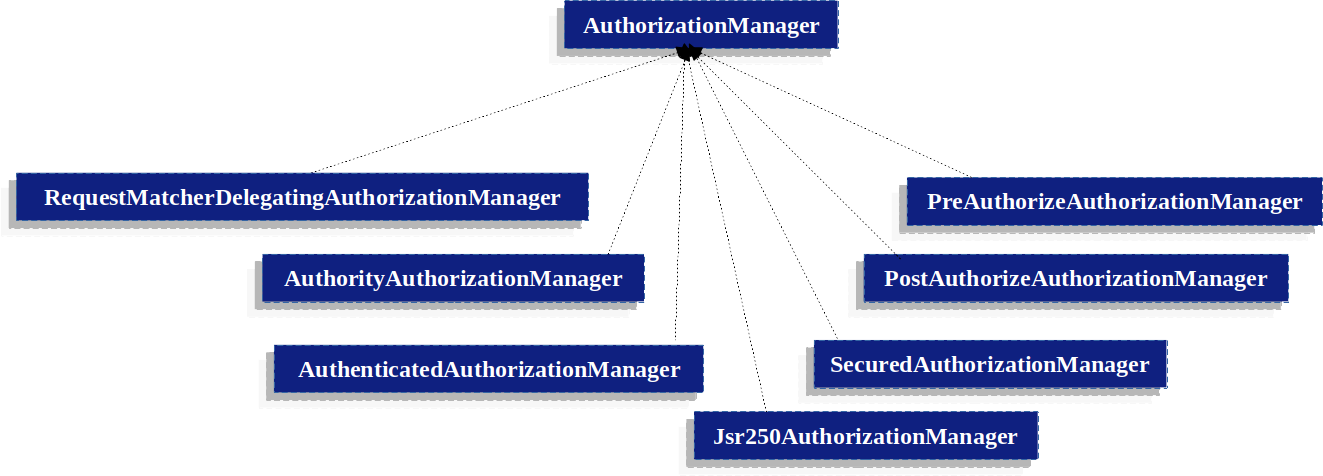網(wǎng)站首頁 編程語言 正文
前言
今天我們重點聊聊授權(quán)方式的另外一種:基于HttpServletRequest配置權(quán)限
基于HttpServletRequest配置權(quán)限
一個典型的配置demo
http.authorizeHttpRequests(requestMatcherRegstry ->
// /admin/** 需要有AMIND角色
requestMatcherRegstry.requestMatchers("/admin/**").hasRole("ADMIN")
// /log/** 只要有AMIND、USER角色之一
.requestMatchers("/log/**").hasAnyRole("ADMIN", "USER")
// 任意請求 只要登錄了即可訪問
.anyRequest().authenticated()
);
從這里也可以看出,要實現(xiàn)基于RBAC,還是比較容易的。也比較容易使用。但是如果想要動態(tài)的增加角色,就需要我們定制AuthorizationManager。
配置原理
HttpSecurity是負(fù)責(zé)構(gòu)建DefaultSecurityFilterChain的。而這個安全過濾器鏈,則是允許我們進(jìn)行配置的。而authorizeHttpRequests方法,正是配置AuthorizationFilter的。而我們傳入的入?yún)?lambada表達(dá)式-則是指引如何配置AuthorizationFilter的。
/**
* 這個方法是HttpSecurity的方法。
* 作用是配置AuthorizationFilter。
* 其入?yún)uthorizeHttpRequestsCustomizer正是讓我們配置AuthorizationFilter的關(guān)鍵。
* Customizer:就是定制。原理比較容易理解,就是我把你需要配置的東西丟給你,你往里面賦值。
* AuthorizeHttpRequestsConfigurer<HttpSecurity>:這個是Configurer的實現(xiàn),負(fù)責(zé)引入過濾器的。這里明顯就是引入AuthorizationFilter
* AuthorizationManagerRequestMatcherRegistry:這個就是我們最終配置的東西。而這個配置的正是我們上面的RequestMatcherDelegatingAuthorizationManager。說白了就是往里面添加哪些路徑對應(yīng)哪些AuthorizationManager。只不過,為了方便使用,也幫我們都封裝好了。不妨繼續(xù)往后看看。
*/
public HttpSecurity authorizeHttpRequests(
Customizer<AuthorizeHttpRequestsConfigurer<HttpSecurity>.AuthorizationManagerRequestMatcherRegistry> authorizeHttpRequestsCustomizer)
throws Exception {
ApplicationContext context = getContext();
// 這里干了三個事情:
// 1. 如果當(dāng)前HttpSecurity不存在AuthorizeHttpRequestsConfigurer,則創(chuàng)建一個,并注冊到當(dāng)前的HttpSecurity對象中。
// 2. 從AuthorizeHttpRequestsConfigurer拿到他的注冊器也就是AuthorizationManagerRequestMatcherRegistry
// 3. 調(diào)用傳入的參數(shù)的customize。如此,我們傳入的lambda表達(dá)式就被調(diào)用了。
authorizeHttpRequestsCustomizer
.customize(getOrApply(new AuthorizeHttpRequestsConfigurer<>(context)).getRegistry());
return HttpSecurity.this;
}
public final class AuthorizationManagerRequestMatcherRegistry
extends AbstractRequestMatcherRegistry<AuthorizedUrl> {
/**
* 這是父類的方法
* C代表的是AuthorizedUrl
*/
public C requestMatchers(String... patterns) {
// 調(diào)用的重載方法第一個參數(shù)為HttpMethod,也就是說,我們還可以指定HTTP請求的方法,例如:POST、GET等
return requestMatchers(null, patterns);
}
@Override
protected AuthorizedUrl chainRequestMatchers(List<RequestMatcher> requestMatchers) {
this.unmappedMatchers = requestMatchers;
return new AuthorizedUrl(requestMatchers);
}
}
public class AuthorizedUrl {
private final List<? extends RequestMatcher> matchers;
public AuthorizationManagerRequestMatcherRegistry permitAll() {
return access(permitAllAuthorizationManager);
}
public AuthorizationManagerRequestMatcherRegistry hasRole(String role) {
return access(withRoleHierarchy(AuthorityAuthorizationManager.hasRole(role)));
}
public AuthorizationManagerRequestMatcherRegistry hasAnyAuthority(String... authorities) {
return access(withRoleHierarchy(AuthorityAuthorizationManager.hasAnyAuthority(authorities)));
}
public AuthorizationManagerRequestMatcherRegistry authenticated() {
return access(AuthenticatedAuthorizationManager.authenticated());
}
public AuthorizationManagerRequestMatcherRegistry access(
AuthorizationManager<RequestAuthorizationContext> manager) {
Assert.notNull(manager, "manager cannot be null");
return AuthorizeHttpRequestsConfigurer.this.addMapping(this.matchers, manager);
}
}
public final class AuthorizeHttpRequestsConfigurer<H extends HttpSecurityBuilder<H>>
extends AbstractHttpConfigurer<AuthorizeHttpRequestsConfigurer<H>, H> {
private AuthorizationManagerRequestMatcherRegistry addMapping(List<? extends RequestMatcher> matchers,
AuthorizationManager<RequestAuthorizationContext> manager) {
for (RequestMatcher matcher : matchers) {
this.registry.addMapping(matcher, manager);
}
return this.registry;
}
}
我們通過lambda表達(dá)式:
requestMatcherRegstry -> requestMatcherRegstry.requestMatchers("/admin/**").hasRole("ADMIN")
配置的正是AuthorizationManagerRequestMatcherRegistry
requestMachers方法,構(gòu)建出AuthorizedUrl,然后通過這個類的hasRole方法注冊當(dāng)前路徑所對應(yīng)的權(quán)限/角色。這個對應(yīng)關(guān)系由RequestMatcherEntry保存。key:RequestMatcher requestMatcher;value: AuthorizationManager。
值得一提的是,這個lambda表達(dá)式以及其鏈?zhǔn)秸{(diào)用看起來簡單方便,但是其內(nèi)部涉及多個類的方法調(diào)用,實在很容易犯迷糊,這是我覺得比較詬病的地方。在我看來,鏈?zhǔn)秸{(diào)用還是同一個返回值(每次都返回this)才能做到在方便至于也能清晰明了,容易理解。
而這里在lambda表達(dá)式內(nèi)部:
- 第一個方法是
requestMatcherRegstry.requestMatchers
是AbstractRequestMatcherRegistry,也就是我們的AuthorizationManagerRequestMatcherRegistry的父類。方法返回值是AuthorizedUrl。 - 第二個方法是
AuthorizedUrl.hasRole
而該方法的返回值為AuthorizationManagerRequestMatcherRegistry。
發(fā)現(xiàn)什么了嗎?鏈?zhǔn)秸{(diào)用還能玩起遞歸,又回到最開始的第一個方法了。而要是我們配置HttpSecurity,直接一連串的鏈?zhǔn)秸{(diào)用,那更是沒譜了。經(jīng)常就是,你只能看著別人這樣配置,然后照貓畫虎。這個鏈?zhǔn)秸{(diào)用咋調(diào)回來的,一頭霧。因為中間可能跨越好幾個不同的類。。。
PS:可能官方也有些意識到這點,所以sample工程都是類似于本文開頭的那樣,傳入一個基于lambda表達(dá)式的Customizer。一個方法配置一個過濾器的SecurityConfigurer。但,如果你翻看源碼,你看到的就是一連串的鏈?zhǔn)秸{(diào)用。最為明顯的一個證明就是HttpSecurity#and方法過期了。因此個人推薦大家用文章開頭的那種方法,相對清晰易理解。
我想說,這么玩是深怕別人搞明白了是嗎???更絕的是,即便你知曉了原理也沒有辦法直接注冊對應(yīng)關(guān)系,除非你使用反射!
這里給大家提個醒,如果你想搞明白你在使用SpringSecurity究竟在配置些什么,那么你就必須要搞明白上面的套路。
設(shè)計方案
Spring Security在5.5版本之后,在鑒權(quán)架構(gòu)上,進(jìn)行了較大的改動。以至于官方也出了遷移指南
| 組件 | 5.5之前 | 5.5之后 |
|---|---|---|
| 過濾器 | FilterSecurityInterceptor | AuthorizationFilter |
| 鑒權(quán)管理器 | AccessDecisionManager | AuthorizationManager |
| 訪問決策投票員 | AccessDecisionVoter | - |
而原來的設(shè)計方案,相較于新的方案,更為復(fù)雜。這里給大家一張官方的UML感受感受:
除卻過濾器外,還需要三個組件來構(gòu)建完整的鑒權(quán):
AccessDecisionManager 、AccessDecisionVoter 、ConfigAttribute。
感興趣的同學(xué)可以自己琢磨琢磨,但已經(jīng)廢棄的方案,這里就不討論了。
5.6之后的新方案
新方案只有一個包羅萬象、且極具擴(kuò)展性的AuthorizationManager
我們前面的配置demo,本質(zhì)上都是在配置RequestMatcherDelegatingAuthorizationManager。他主要是記錄每一個路徑對應(yīng)的AuthorizationManager<HttpServletRequest>。當(dāng)有請求過來時,只需要遍歷每一個路徑,當(dāng)找到匹配者就委托該AuthorizationManager<HttpServletRequest>進(jìn)行鑒權(quán)。
在我們的配置demo中,對應(yīng)的是AuthoriztyAuthorizationManager和AuthenticatedAuthorizationManager。前者,意味著我們配置的是角色/權(quán)限,后者對應(yīng)的是authenticated()這個方法。
如果你認(rèn)真看了這個關(guān)系圖,那么一定會發(fā)現(xiàn)右邊的4個實現(xiàn)類正是我們在上一文講述基于方法配置權(quán)限中所使用到的。
鑒權(quán)源碼分析
權(quán)限過濾的入口:AuthorizationFilter
public class AuthorizationFilter extends GenericFilterBean {
@Override
public void doFilter(ServletRequest servletRequest, ServletResponse servletResponse, FilterChain chain)
throws ServletException, IOException {
// 類型轉(zhuǎn)換
HttpServletRequest request = (HttpServletRequest) servletRequest;
HttpServletResponse response = (HttpServletResponse) servletResponse;
// 是否需要執(zhí)行鑒權(quán)
if (this.observeOncePerRequest && isApplied(request)) {
chain.doFilter(request, response);
return;
}
// /error和異步請求不處理
if (skipDispatch(request)) {
chain.doFilter(request, response);
return;
}
// 是否已經(jīng)執(zhí)行過鑒權(quán)邏輯了
String alreadyFilteredAttributeName = getAlreadyFilteredAttributeName();
request.setAttribute(alreadyFilteredAttributeName, Boolean.TRUE);
try {
// 從SecurityContextHolder中獲取憑證,并通過AuthorizationManager做出決策
AuthorizationDecision decision = this.authorizationManager.check(this::getAuthentication, request);
// 發(fā)布鑒權(quán)事件
this.eventPublisher.publishAuthorizationEvent(this::getAuthentication, request, decision);
if (decision != null && !decision.isGranted()) {
// 拒絕訪問異常
throw new AccessDeniedException("Access Denied");
}
// 正常執(zhí)行后續(xù)業(yè)務(wù)邏輯
chain.doFilter(request, response);
}
finally {
// 處理完業(yè)務(wù)邏輯后,為當(dāng)前請求清理標(biāo)識
request.removeAttribute(alreadyFilteredAttributeName);
}
}
}
RequestMatcherDelegatingAuthorizationManager
public final class RequestMatcherDelegatingAuthorizationManager implements AuthorizationManager<HttpServletRequest> {
@Override
public AuthorizationDecision check(Supplier<Authentication> authentication, HttpServletRequest request) {
// 遍歷每一個已經(jīng)登錄好的路徑,找到對應(yīng)的AuthorizationManager<RequestAuthorizationContext>>
for (RequestMatcherEntry<AuthorizationManager<RequestAuthorizationContext>> mapping : this.mappings) {
RequestMatcher matcher = mapping.getRequestMatcher();
// 匹配當(dāng)前請求
MatchResult matchResult = matcher.matcher(request);
if (matchResult.isMatch()) {
// 找到匹配的AuthorizationManager就直接調(diào)用check方法并返回鑒權(quán)結(jié)果
AuthorizationManager<RequestAuthorizationContext> manager = mapping.getEntry();
return manager.check(authentication,
new RequestAuthorizationContext(request, matchResult.getVariables()));
}
}
// 沒有匹配的AuthorizationManager則返回拒絕當(dāng)前請求
return DENY;
}
}
可見,在沒有匹配的AuthorizationManager的情況下,默認(rèn)是拒絕請求的。
總結(jié)
-
我們在配置中配置的url被封裝成RequestMatcher,而hasRole被封裝成AuthorityAuthorizationManager。進(jìn)行注冊,在請求過來時,便通過遍歷所有注冊好的RequestMatch進(jìn)行匹配,存在匹配就調(diào)用
AuthorizationManager<RequestAuthorizationContext>#check方法。 -
配置的鏈?zhǔn)秸{(diào)用,會跨越多個不同的類,最終又回到第一個對象的類型。
后記
本文我們聊了基于HttpRequest配置權(quán)限的方方面面。相信這里有一個點應(yīng)該會引起大家的注意:配置。下一次,我們聊聊Spring Security的配置體系。
原文鏈接:https://blog.csdn.net/Evan_L/article/details/136605794
- 上一篇:沒有了
- 下一篇:沒有了
相關(guān)推薦
- 2022-08-13 從源碼理解SpringBootServletInitializer的作用
- 2022-07-04 pyqt5-tools安裝失敗的詳細(xì)處理方法_python
- 2023-08-01 elementui DateTimePicker組件 限制時間范圍(包含時分秒)
- 2023-04-07 C#?PadLeft、PadRight用法詳解_C#教程
- 2025-02-10 window11 系統(tǒng)安裝 yarn
- 2022-07-02 運行react項目時出現(xiàn)Uncaught ReferenceError: process is no
- 2021-12-05 React實現(xiàn)一個通用骨架屏組件示例_React
- 2022-01-12 nvm-windows使用與避坑指南,npm沒反應(yīng)也不報錯怎么辦
- 欄目分類
-
- 最近更新
-
- window11 系統(tǒng)安裝 yarn
- 超詳細(xì)win安裝深度學(xué)習(xí)環(huán)境2025年最新版(
- Linux 中運行的top命令 怎么退出?
- MySQL 中decimal 的用法? 存儲小
- get 、set 、toString 方法的使
- @Resource和 @Autowired注解
- Java基礎(chǔ)操作-- 運算符,流程控制 Flo
- 1. Int 和Integer 的區(qū)別,Jav
- spring @retryable不生效的一種
- Spring Security之認(rèn)證信息的處理
- Spring Security之認(rèn)證過濾器
- Spring Security概述快速入門
- Spring Security之配置體系
- 【SpringBoot】SpringCache
- Spring Security之基于方法配置權(quán)
- redisson分布式鎖中waittime的設(shè)
- maven:解決release錯誤:Artif
- restTemplate使用總結(jié)
- Spring Security之安全異常處理
- MybatisPlus優(yōu)雅實現(xiàn)加密?
- Spring ioc容器與Bean的生命周期。
- 【探索SpringCloud】服務(wù)發(fā)現(xiàn)-Nac
- Spring Security之基于HttpR
- Redis 底層數(shù)據(jù)結(jié)構(gòu)-簡單動態(tài)字符串(SD
- arthas操作spring被代理目標(biāo)對象命令
- Spring中的單例模式應(yīng)用詳解
- 聊聊消息隊列,發(fā)送消息的4種方式
- bootspring第三方資源配置管理
- GIT同步修改后的遠(yuǎn)程分支
